Lights Over Lapland is excited to announce that our aurora webcam will be up and running 365 days per year! You can now enjoy watching the Midnight Sun and all of the other drama in the sky above Abisko National Park, Sweden here. | | |
SOLAR WIND, INCOMING: A wide hole is opening in the sun's atmosphere, and it is spewing a stream of solar wind toward Earth. G1-class geomagnetic storms are possible when the gaseous material arrives on April 19-20. Sky watchers between 50o and 60o N latitude should also be alert for STEVE, which tends to appear in that latitude range during springtime geomagnetic storms. Free: Aurora Alerts
NEW COSMIC RAY DATA, COURTESY OF CAPT. UNDERPANTS: On March 29th, the students of Earth to Sky Calculus launched a space weather balloon to measure cosmic rays in the stratosphere--something they've been doing for more than 3 years in collaboration with Spaceweather.com. Their unique cosmic ray monitoring program is not supported by the NSF, NASA or government grants. Instead, we rely on individual sponsors. In this case, Capt. Underpants!
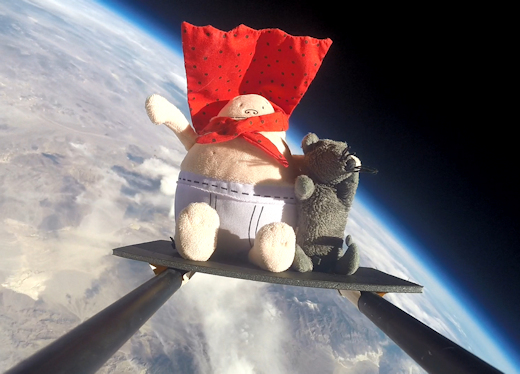
Actually, it was Tracy Stewart and Brian Elkington of West Valley City, UT, who did the sponsoring. They are the parents of two young scientists, Maxwell and Timothy Elkington, who wanted to fly Capt. Underpants and his sidekick Mousy to the edge of space. Tracy and Brian sponsored the launch of an Earth to Sky balloon with cosmic ray sensors onboard--and Capt. Underpants went along for the ride.
And a wild ride it was. The payload traveled more than 111,000 feet above Earth's surface, experiencing temperatures as low as -60 C and air pressures less than 0.2% of sea level. The cosmic ray dose rate at the apex of the flight (circled in red) was more than 100 times greater than on the Earth below:
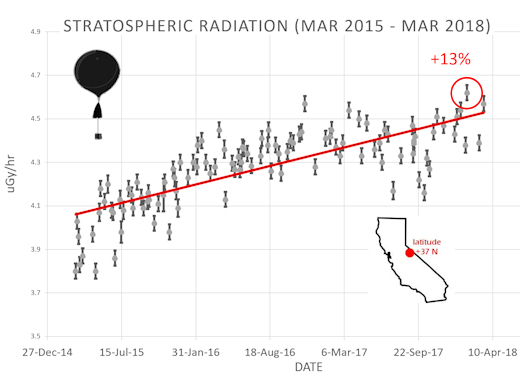
After the balloon exploded, as planned, the payload parachuted back to Earth, landing in a rugged canyon near Panamint Butte on the verge of Death Valley. The recovery team hiked 14 miles to recover the payload. Capt. Underpants and Mousy survived the harrowing trip with a big grin and brought back great cosmic ray data for the students to analyze.
Thank you Tracy and Brian for supporting our program. PS: A video of Capt. Underpants in flight is being prepared. Stay tuned.
SURPRISE ASTEROID FLYBY: With little warning, a relatively large asteroid flew through the Earth-Moon system on April 15th only 192,200 km (0.5 LD) from our planet. 2018 GE3 was discovered by the Catalina Sky Survey approaching Earth on April 14th. Hours later, amateur astronomer Michael Jäger of Weißenkirchen Austria video-recorded the space rock rushing through the southern constellation Serpens:
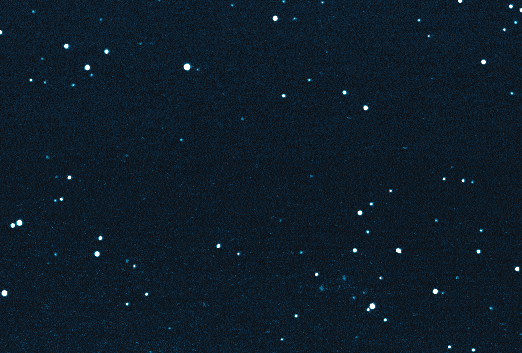
"According to wikipedia, 2018 GE3 is the largest known asteroid to pass that close to Earth in observational history," says Jäger. "It was shining like a 13th magnitude star at the time of my observations."
Based on the intensity of its reflected sunlight, 2018 GE3 must be 48 to 110 meters wide, according to NASA-JPL. This puts it into the same class as the 60-meter Tunguska impactor that leveled a forest in Siberia in 1908. A more recent point of comparison is the Chelyabinsk meteor--a ~20-meter asteroid that exploded in the atmosphere over Russia on Feb. 15, 2013, shattering windows and toppling onlookers as a fireball brighter than the sun blossomed in the blue morning Ural sky. 2018 GE3 could be 5 to 6 times wider than that object.
If 2018 GE3 had hit Earth, it would have caused regional, not global, damage, and might have disintegrated in the atmosphere before reaching the ground. Nevertheless, it is a significant asteroid, illustrating how even large space rocks can still take us by surprise. 2018 GE3 was found less than a day before before its closest approach.
Based on an observational arc of only 1 day, 2018 GE3 appears to follow an elliptical orbit which stretches from the asteroid belt to deep inside the inner solar system. Every ~2.5 years the space rock crosses the orbits of Mercury, Venus, Earth, and Mars--although not necessarily making close approaches to the planets themselves. An interactive 3D orbit of the asteroid is available from JPL: explore it here!
Realtime Space Weather Photo Gallery
MOTHER'S DAY IS LESS THAN 1 MONTH AWAY:On March 5, 2018, the students of Earth to Sky Calculus flew a cosmic ray balloon to the stratosphere, more than 94,000 feet above Earth's surface. This sterling silver Mother's Day pendant went along for the ride:
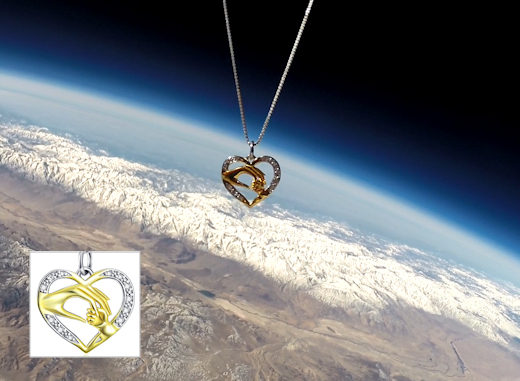
You can have it for $129.95. The students are selling these pendants as a fund-raiser for their cosmic ray monitoring program. All proceeds support atmospheric radiation measurements and hands-on STEM education.
Each pendant comes with a greeting card showing the jewelry in flight and telling the story of its journey to the stratosphere and back again. Mom-satisfaction guaranteed.
Far Out Gifts: Earth to Sky Store
All proceeds support hands-on STEM education
Realtime Aurora Photo Gallery
Every night, a network of
NASA all-sky cameras scans the skies above the United States for meteoritic fireballs. Automated software maintained by NASA's Meteoroid Environment Office calculates their orbits, velocity, penetration depth in Earth's atmosphere and many other characteristics. Daily results are presented here on Spaceweather.com.
On Apr. 16, 2018, the network reported 6 fireballs.
(6 sporadics)

In this diagram of the inner solar system, all of the fireball orbits intersect at a single point--Earth. The orbits are color-coded by velocity, from slow (red) to fast (blue). [Larger image] [movies]
Potentially Hazardous Asteroids (
PHAs) are space rocks larger than approximately 100m that can come closer to Earth than 0.05 AU. None of the known PHAs is on a collision course with our planet, although astronomers are finding
new ones all the time.
On April 16, 2018 there were 1907 potentially hazardous asteroids.
 |
Recent & Upcoming Earth-asteroid encounters: | Asteroid | Date(UT) | Miss Distance | Velocity (km/s) | Diameter (m) |
| 2018 GG | 2018-Apr-11 | 4.7 LD | 13.9 | 43 |
| 363599 | 2018-Apr-12 | 19.3 LD | 24.5 | 224 |
| 2018 GD2 | 2018-Apr-12 | 0.8 LD | 7.8 | 5 |
| 2018 GP | 2018-Apr-13 | 4.4 LD | 8.8 | 14 |
| 2018 GV1 | 2018-Apr-13 | 4.8 LD | 8.9 | 12 |
| 2018 GD5 | 2018-Apr-14 | 3.6 LD | 6 | 10 |
| 2014 UR | 2018-Apr-14 | 9.3 LD | 4.4 | 17 |
| 2018 GH2 | 2018-Apr-14 | 14.3 LD | 7.1 | 22 |
| 2018 GE3 | 2018-Apr-15 | 0.5 LD | 29.6 | 63 |
| 2018 GC2 | 2018-Apr-17 | 9 LD | 4.9 | 15 |
| 2018 GP4 | 2018-Apr-17 | 11.4 LD | 9.3 | 18 |
| 2018 GK4 | 2018-Apr-17 | 5.9 LD | 10.8 | 20 |
| 2018 GS3 | 2018-Apr-20 | 8.5 LD | 19.8 | 22 |
| 2016 JP | 2018-Apr-20 | 12 LD | 12.7 | 214 |
| 2018 GR1 | 2018-Apr-21 | 18.2 LD | 16.3 | 52 |
| 2018 GG4 | 2018-Apr-23 | 9.8 LD | 14.9 | 19 |
| 2012 XL16 | 2018-Apr-23 | 15.8 LD | 6.1 | 28 |
| 2018 GH | 2018-Apr-25 | 14.6 LD | 10.7 | 89 |
| 2018 GB2 | 2018-Apr-27 | 17.2 LD | 14.6 | 94 |
| 2013 US3 | 2018-Apr-29 | 10.1 LD | 7.7 | 214 |
| 2018 GO4 | 2018-Apr-29 | 11.8 LD | 8.6 | 45 |
| 2018 GY1 | 2018-Apr-29 | 13.2 LD | 16.7 | 135 |
| 2018 FV4 | 2018-Apr-29 | 17.7 LD | 6.5 | 58 |
| 2002 JR100 | 2018-Apr-29 | 10.8 LD | 7.7 | 49 |
| 1999 FN19 | 2018-May-07 | 9.7 LD | 5.7 | 118 |
| 2016 JQ5 | 2018-May-08 | 6.3 LD | 10.4 | 9 |
| 388945 | 2018-May-09 | 6.5 LD | 9 | 295 |
| 2018 GR2 | 2018-May-11 | 13.4 LD | 9.8 | 109 |
| 1999 LK1 | 2018-May-15 | 13.3 LD | 10 | 141 |
| 2018 GL1 | 2018-May-18 | 14.3 LD | 5.2 | 66 |
| 68347 | 2018-May-29 | 9.5 LD | 13.3 | 389 |
| 2013 LE7 | 2018-May-31 | 17.8 LD | 1.7 | 12 |
| 2018 EJ4 | 2018-Jun-10 | 5.6 LD | 6.2 | 195 |
| 2015 DP155 | 2018-Jun-11 | 9 LD | 4.4 | 170 |
Notes: LD means "Lunar Distance." 1 LD = 384,401 km, the distance between Earth and the Moon. 1 LD also equals 0.00256 AU. MAG is the visual magnitude of the asteroid on the date of closest approach. | | Cosmic Rays in the Atmosphere |
Readers, thank you for your patience while we continue to develop this new section of Spaceweather.com. We've been working to streamline our data reduction, allowing us to post results from balloon flights much more rapidly, and we have developed a new data product, shown here:
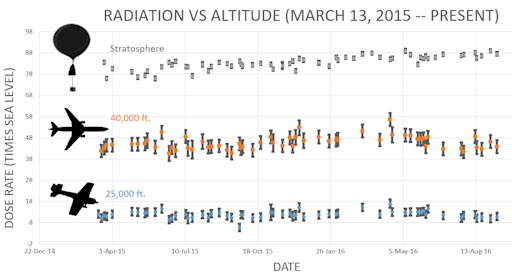
This plot displays radiation measurements not only in the stratosphere, but also at aviation altitudes. Dose rates are expessed as multiples of sea level. For instance, we see that boarding a plane that flies at 25,000 feet exposes passengers to dose rates ~10x higher than sea level. At 40,000 feet, the multiplier is closer to 50x. These measurements are made by our usual cosmic ray payload as it passes through aviation altitudes en route to the stratosphere over California.
What is this all about? Approximately once a week, Spaceweather.com and the students of Earth to Sky Calculus fly space weather balloons to the stratosphere over California. These balloons are equipped with radiation sensors that detect cosmic rays, a surprisingly "down to Earth" form of space weather. Cosmic rays can seed clouds, trigger lightning, and penetrate commercial airplanes. Furthermore, there are studies ( #1, #2, #3, #4) linking cosmic rays with cardiac arrhythmias and sudden cardiac death in the general population. Our latest measurements show that cosmic rays are intensifying, with an increase of more than 13% since 2015:
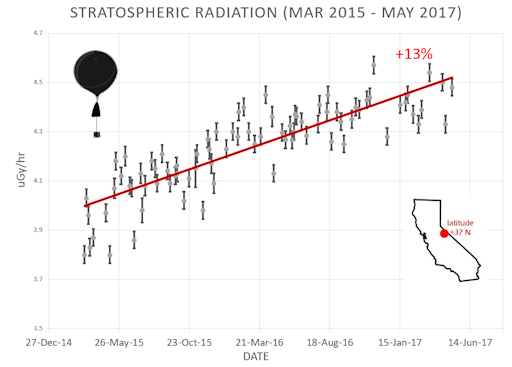
Why are cosmic rays intensifying? The main reason is the sun. Solar storm clouds such as coronal mass ejections (CMEs) sweep aside cosmic rays when they pass by Earth. During Solar Maximum, CMEs are abundant and cosmic rays are held at bay. Now, however, the solar cycle is swinging toward Solar Minimum, allowing cosmic rays to return. Another reason could be the weakening of Earth's magnetic field, which helps protect us from deep-space radiation.
The radiation sensors onboard our helium balloons detect X-rays and gamma-rays in the energy range 10 keV to 20 MeV. These energies span the range of medical X-ray machines and airport security scanners.
The data points in the graph above correspond to the peak of the Reneger-Pfotzer maximum, which lies about 67,000 feet above central California. When cosmic rays crash into Earth's atmosphere, they produce a spray of secondary particles that is most intense at the entrance to the stratosphere. Physicists Eric Reneger and Georg Pfotzer discovered the maximum using balloons in the 1930s and it is what we are measuring today.
| | The official U.S. government space weather bureau |
| | The first place to look for information about sundogs, pillars, rainbows and related phenomena. |
| | Researchers call it a "Hubble for the sun." SDO is the most advanced solar observatory ever. |
| | 3D views of the sun from NASA's Solar and Terrestrial Relations Observatory |
| | Realtime and archival images of the Sun from SOHO. |
| | from the NOAA Space Environment Center |
| | fun to read, but should be taken with a grain of salt! Forecasts looking ahead more than a few days are often wrong. |
| | from the NOAA Space Environment Center |
| | the underlying science of space weather |
 | Reviews here can help you to pick up best memory foam mattresses. |
| | These links help Spaceweather.com stay online. Thank you to our supporters! |
| | | | | | |

